Mimicking an enzyme
The catalytic oxidation of the enzyme Tyroniase was reconstructed for the first time by a synthetic molecule mimicking the structure and arrangement of the active sites.
Inspection of enzymatic reactions often provides chemists strategic direction to approach difficult molecular transformations. Paramount to efficiency is the mechanistic route, so attempting duplication of an enzymatic mechanism, while challenging, is a rational method of catalyst design. Tyrosinase, found in nearly all species of Life, catalyzes the aerobic oxidation of phenols to catechols through the intermediacy of a dioxygen-derived, side-on bonded peroxide coordinated to two copper centers.
In a recent interdisciplinary study which appears in early view on Angewandte Chemie online, Herres-Pawlis (LMU Munich), Stack (Stanford University) and Rübhausen (CFEL) et al. present a tyrosinase mimic capable of regioselective hydroxylation of a wide range of phenols, including substrates incompatible with the enzyme, in both stoichiometric and catalytic modes.
They propose the efficiency of this synthetic binuclear copper catalyst is due to the stability of its oxygenated form under ambient conditions, rarely observed, and its operation through a mechanism demonstrated to parallel that accepted for tyrosinase, the natural world’s common method of phenolic hydroxylation. The researchers combine a sophisticated ligand design with thorough spectroscopic analysis (resonance Raman and XAS spectroscopy) and theoretical investigations. The kinetic studies together with the substrate scope evaluation turns out to be the key for the catalyst development. Important parts of this study have been supported by the DFG within the research unit FOR1405 „Dynamics of Electron Transfer Processes within Transition Metal Sites in Biological and Bioinorganic Systems“.
This article was also chosen for graphical display on the cover page of the Angewandte Chemie International Edition.
